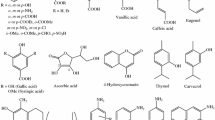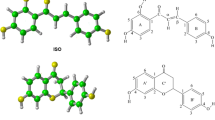Abstract
It is well known that the bond dissociation enthalpy (BDE) of the O–H group is related to the hydrogen atom transfer (HAT) mechanism of free radical scavenging that is preferred in gas-phase and non-polar solvents. The present work shows that the BDE may also be related to radical scavenging processes taking place in polar solvents, i.e., single electron transfer followed by proton transfer (SET-PT) and sequential proton loss electron transfer (SPLET). This is so because the total energy requirements related to the SET-PT [sum of the ionization potential (IP) and proton dissociation enthalpy (PDE)] and the SPLET [sum of the proton affinity (PA) and electron transfer enthalpy (ETE)] are perfectly correlated with the BDE. This could explain why the published data for polyphenolic antioxidant activity measured by various assays are better correlated with the BDE than with other reaction enthalpies involved in radical scavenging mechanisms, i.e., the IP, PDE, PA and ETE. The BDE is fairly well able to rank flavonoids as antioxidants in any medium, but to conclude which radical scavenging mechanism represents the most probable reaction pathway from the thermodynamic point of view, the IP and PA (ETE) should also be considered. This is exemplified in the case of the radical scavenging activity of 25 flavonoids.

Total energy requirements related to the SET-PT and SPLET mechanisms are equivalent to those of the HAT mechanism and are correlated perfectly with the BDE values.




Similar content being viewed by others
Abbreviations
- HAT:
-
Hydrogen atom transfer
- BDE:
-
Bond dissociation enthalpy
- SET-PT:
-
Single electron transfer followed by proton transfer
- IP:
-
Ionization potential
- PDE:
-
Proton dissociation enthalpy
- SPLET:
-
Sequential proton loss electron transfer
- PA:
-
Proton affinity
- ETE:
-
Electron transfer enthalpy
References
Pieta P-G (2000) Flavonoids as antioxidants. J Nat Prod 63:1035–1042
Fraga CG, Galleano M, Verstraeten SV, Oteiza PI (2010) Basic biochemical mechanisms behind the health benefits of polyphenols. Mol Asp Med 31:435–445
Dangles O (2012) Antioxidant activity of plant phenols: chemical mechanisms and biological significance. Curr Org Chem 16:692–714
Prochazkova D, Boušova I, Wilhelmova N (2011) Antioxidant and prooxidant properties of flavonoids. Fitoterapia 82:513–523
Havsteen BH (2002) The biochemistry and medical significance of the flavonoids. Pharmacol Ther 96:67–202
Wright JS, Johnson ER, DiLabio GA (2001) Predicting the activity of phenolic antioxidants: theoretical method, analysis of substituent effects, and application to major families of antioxidants. J Am Chem Soc 123:1173–1183
Mayer JM (2004) Proton-coupled electron transfer: a reaction chemist’s view. Annu Rev Phys Chem 55:363–390
Litwinienko G, Ingold KU (2007) Solvent effects on the rates and mechanisms of reaction of phenols with free radicals. Acc Chem Res 40:222–230
Klein E, Lukeš V, Ilčin M (2007) DFT/B3LYP study of tocopherols and chromans antioxidant action energetics. Chem Phys 336:51–57
Zhang H-Y, Ji H-F (2006) How vitamin E scavenges DPPH radicals in polar protic media. New J Chem 30:503–504
Foti MC, Daquino C, Geraci C (2004) Electron-transfer reaction of cinnamic acids and their methyl esters with the DPPH• radical in alcoholic solutions. J Org Chem 69:2309–2314
Amić D, Lučić B (2010) Reliability of bond dissociation enthalpy calculated by the PM6 method and experimental TEAC values in antiradical QSAR of flavonoids. Bioorg Med Chem 18:28–35
Marković Z, Milenković D, Đorović J, Dimitrić Marković JM, Stepanić V, Lučić B, Amić D (2012) PM6 and DFT study of free radical scavenging activity of morin. Food Chem 134:1754–1760
Marković Z, Milenković D, Đorović J, Dimitrić Marković JM, Stepanić V, Lučić B, Amić D (2012) Free radical scavenging activity of morin 2′-O− phenoxide anion. Food Chem 135:2070–2077
Burda S, Oleszek W (2001) Antioxidant and antiradical activities of flavonoids. J Agric Food Chem 49:2774–2779
Anouar E, Calliste CA, Košinova P, Di Meo F, Duroux JL, Champavier Y, Marakchi K, Trouillas P (2009) Free radical scavenging properties of guaiacol oligomers: a combined experimental and quantum study of guaiacyl-moiety role. J Phys Chem A 113:13881–13891
Anouar E, Košinova P, Kozlowski D, Mokrini R, Duroux JL, Trouillas P (2009) New aspects of the antioxidant properties of phenolic acids: a combined theoretical and experimental approach. Phys Chem Chem Phys 11:7659–7668
MOPAC2009™ (2009) Stewart computational chemistry, Version 11.366 W. http://openmopac.net/MOPAC2009.html
Rimarčik J, Lukeš V, Klein E, Ilčin M (2010) Study of the solvent effect on the enthalpies of homolytic and heterolytic N–H bond cleavage in p-phenylenediamine and tetracyano-p-phenylenediamine. J Mol Struct (THEOCHEM) 952:25–30
Wright JS, Carpenter DJ, McKay DJ, Ingold KU (1997) Theoretical calculation of substituent effects on the O−H bond strength of phenolic antioxidants related to vitamin E. J Am Chem Soc 119:4245–4252
Nenadis N, Wang L-F, Tsimidou MZ, Zhang H-Y (2005) Radical scavenging potential of phenolic compounds encountered in O. europaea products as indicated by calculation of bond dissociation enthalpy and ionization potential values. J Agric Food Chem 53:295–299
Foti MC, Daquino C, Mackie ID, DiLabio GA, Ingold KU (2008) Reaction of phenols with the 2,2-diphenyl-1-picrylhydrazyl radical. Kinetics and DFT calculations applied to determine ArO-H bond dissociation enthalpies and reaction mechanism. J Org Chem 73:9270–9282
Nenadis N, Tsimidou MZ (2012) Contribution of DFT computed molecular descriptors in the study of radical scavenging activity trend of natural hydroxybenzaldehydes and corresponding acids. Food Res Int 48:538–543
Trouillas P, Marsal P, Siri D, Lazzaroni R, Duroux J-L (2006) A DFT study of the reactivity of OH groups in quercetin and taxifolin antioxidants: the specificity of the 3-OH site. Food Chem 97:679–688
McPhail DB, Hartley RC, Gardner PT, Duthie GG (2003) Kinetic and stoichiometric assessment of the antioxidant activity of flavonoids by electron spin resonance spectroscopy. J Agric Food Chem 51:1684–1690
Leopoldini M, Marino T, Russo N, Toscano M (2004) Density functional computations of the energetic and spectroscopic parameters of quercetin and its radicals in the gas phase and in solvent. Theor Chem Acc 111:210–216
Li M-J, Liu L, Fu Y, Guo Q-X (2007) Accurate bond dissociation enthalpies of popular antioxidants predicted by the ONIOM-G3B3 method. J Mol Struct (THEOCHEM) 815:1–9
Mendoza-Wilson AM, Lardizabal-Gutierrez D, Torres-Moye E, Fuentes-Cobas L, Balandran-Quintana RR, Camacho-Davila A, Quintero-Ramos A, Glossman-Mitnik D (2007) Optimized structure and thermochemical properties of flavonoids determined by the CHIH(medium)–DFT model chemistry versus experimental techniques. J Mol Struct 871:114–130
Musialik M, Kuzmicz R, Pawlowski TS, Litwinienko G (2009) Acidity of hydroxyl groups: an overlooked influence on antiradical properties of flavonoids. J Org Chem 74:2699–2709
Estevez L, Otero N, Mosquera RA (2010) A computational study on the acidity dependence of radical-scavenging mechanisms of anthocyanidins. J Phys Chem B 114:9706–9712
Leon-Carmona JR, Alvarez-Idaboy JR, Galano A (2012) On the peroxyl scavenging activity of hydroxycinnamic acid derivatives: mechanisms, kinetics, and importance of the acid-base equilibrium. Phys Chem Chem Phys 14:12534–12543
Rong Y, Wang Z, Wu J, Zhao B (2012) A theoretical study on cellular antioxidant activity of selected flavonoids. Spectrochim Acta A 93:235–239
Amić D, Davidović-Amić D, Bešlo D, Rastija V, Lučić B, Trinajstić N (2007) SAR and QSAR of the antioxidant activity of flavonoids. Curr Med Chem 14:827–845
Kozlowski D, Trouillas P, Calliste C, Marsal P, Lazzaroni R, Duroux J-L (2007) Density functional theory study of the conformational, electronic, and antioxidant properties of natural chalcones. J Phys Chem A 111:1138–1145
Lemanska K, Szymusiak H, Tyrakowska B, Zielinski R, Soffers AEMF, Rietjens IMCM (2001) The influence of pH on antioxidant properties and the mechanism of antioxidant action of hydroxyflavones. Free Radic Biol Med 31:869–881
Leopoldini M, Marino T, Russo N, Toscano M (2004) Antioxidant properties of phenolic compounds: H-atom versus electron transfer mechanism. J Phys Chem A 108:4916–4922
Leopoldini M, Russo N, Toscano M (2011) The molecular basis of working mechanisms of natural polyphenolic antioxidants. Food Chem 125:288–306
Vaganek A, Rimarčik J, Lukeš V, Klein E (2012) On the energetics of homolytic and heterolytic O–H bond cleavage in flavonoids. Comput Theor Chem 991:192–200
Zhang H-Y, Sun Y-M, Wang X-L (2003) Substituent effects on O–H bond dissociation enthalpies and ionization potentials of catechols: a DFT study and its implications in the rational design of phenolic antioxidants and elucidation of structure—activity relationships for flavonoid antioxidants. Chem Eur J 9:502–508
Wright JS, Shadnia H (2008) Computational modeling of substituent effects on phenol toxicity. Chem Res Toxicol 21:1426–1431
Galano A, Alvarez-Diduk R, Ramirez-Silva MT, Alarcon-Angeles G, Rojas-Hernandez A (2009) Role of the reacting free radicals on the antioxidant mechanism of curcumin. Chem Phys 363:13–23
Thavasi V, Bettens RPA, Leong LP (2009) Temperature and solvent effects on radical scavenging ability of phenols. J Phys Chem A 113:3068–3077
Litwinienko G, Mulder P (2009) Comment on “Temperature and solvent effects on radical scavenging ability of phenols”. J Phys Chem A 113:14014–14016
Woldu AS, Mai J (2012) A novel relationship between the radical-scavenging activity of flavonoids and enthalpy of formation revealed with Hartree-Fock computations and thermochemical deduction. Redox Rep 17:115–130
Amić D, Davidović-Amić D, Bešlo D, Trinajstić N (2003) Structure-radical scavenging activity relationships of flavonoids. Croat Chem Acta 76:55–61
Amić D, Lučić B, Kovačević G, Trinajstić N (2009) Bond dissociation enthalpies calculated by the PM3 method confirm activity cliffs in radical scavenging of flavonoids. Mol Divers 13:27–36
Bors W, Heller W, Michel C, Saran M (1990) Flavonoids as antioxidants: determination of radical-scavenging efficiencies. In: Packer L, Glazer AN (eds) Methods in Enzymology, vol 186. Academic Press, San Diego, pp 343–355
Acknowledgments
This work was supported by the Ministry of Science, Education and Sports of the Republic of Croatia (Projects Nos.: 079-0000000-3211, 098-1770495-2919, 098-0982464-2511, and Croatia-Serbia Bilateral agreement 2011–2012), and by the Ministry of Science of the Republic of Serbia (Project Nos.: 172015, 69-00-74/2010-02, and Serbia-Croatia Bilateral agreement 2011–2012). We also gratefully acknowledge the anonymous reviewers for their constructive comments.
Author information
Authors and Affiliations
Corresponding author
Rights and permissions
About this article
Cite this article
Amić, D., Stepanić, V., Lučić, B. et al. PM6 study of free radical scavenging mechanisms of flavonoids: why does O–H bond dissociation enthalpy effectively represent free radical scavenging activity?. J Mol Model 19, 2593–2603 (2013). https://doi.org/10.1007/s00894-013-1800-5
Received:
Accepted:
Published:
Issue Date:
DOI: https://doi.org/10.1007/s00894-013-1800-5




